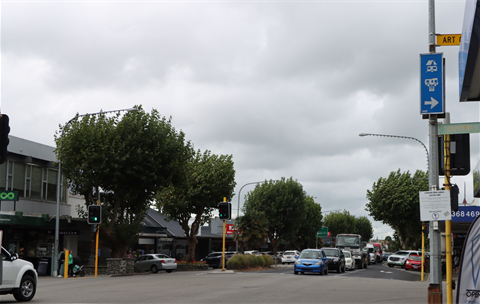Have your say on the future of the Oxford Street Plane Trees
Published on March 31, 2023

Horowhenua District Council seeks direction on whether to remove 27 of the approximately 38 London Plane Trees (Platanus x acerfolia) planted along Oxford Street, Levin on State Highway 1, between Queen Street West and Devon Street, across a distance of 300 metres.
Council is proposing to remove the trees in response to several challenges that have arisen over the years. Local retailers have raised concerns about leaf fall and flooding caused by the trees, and some have requested that the trees be removed.
"Council has received various complaints about flooding affecting business owners and their premises. The fact that the trees could be pollarded (trimmed) historically meant that they could be pruned annually, biennially, or triennially to maintain a reasonable scale as was the case on Oxford Street. However, pollarding of the trees ceased in 1993, leading to the trees having a much denser crown and a lot more leaves than would be expected in a woodland tree or one grown in the open," says Arthur Nelson, Parks and Property Manager at Horowhenua District Council.
"The trees are causing damage to pavements, kerbing and roading. Some of the trees have also been identified as having decay and structural defects, showing the physiological stress they are under due to growing in unfavourable conditions as many of them are surrounded by asphalt," Nelson explains.
Monique Davidson, Council's Chief Executive says, "Council has invested heavily in managing this issue in the past, but it has become clear that a more satisfactory solution is needed. There are various arguments in favour and against the removal or retention of the trees and Council needs to decide on the future treatment of the Plane Trees on Oxford Street."
These trees are classed as Notable Trees under the Operative District Plan and Notable Trees cannot be removed unless they are dead or pose an immediate danger to life or property. Consequently, removing trees that do not meet this criterion requires a resource consent process under the Resource Management Act.
The removal of the trees would consist of cutting each tree off at the base, grinding the stumps to sit below the adjoining asphalt level and their former locations then re-sealed in asphalt, and where practicable, converted back into parking spaces.
Davidson adds, "The Levin Town Centre Strategy, known as ‘Transforming Taitoko/Levin’, outlines the community's desired outcomes for the town centre and offers a vision for its transformation into a more vibrant, resilient, and sustainable place. The strategy proposes ideas such as rain gardens and native plantings to enhance the appearance of the town centre, filter stormwater, and promote biodiversity. The strategy also emphasises the potential of bringing vegetation into the town centre to improve the environment and enhance its appeal, as well as highlighting the district's unique and diverse natural landscape."
Davidson states that the aspirations in relation to the Transforming Taitoko/Levin Strategy and the Ōtaki to North of Levin expressway (Ō2NL) all point towards the necessity of taking a long-term approach to this matter.
Public notification provides an opportunity for the public to provide feedback on the application. Making a submission on a proposal is an effective way to get involved with council decisions under the Resource Management Act. Making a submission on whether the trees can be removed will help ensure democratic community outcomes on decisions are achieved.
How to make a submission on the notified resource consent
Submissions can be made online via Council's website or in writing to Council.
Submissions close at 4:45pm on Tuesday 2 May 2023.
For more information, visit horowhenua.govt.nz/PlaneTrees